Spatio-Temporal Characteristics of Air Quality Index (AQI) over Northwest China
Abstract
:1. Introduction
2. Materials and Methods
2.1. Site Selection
2.2. Data Collection
2.3. Air Quality Index (AQI)
- Class I: 0–50 (Green), Good
- Class II: 51–100 (Yellow), Moderate
- Class III: 101–150 (Orange), Unhealthy for Sensitive Groups
- Class IV: 151–200 (Red), Unhealthy
- Class V: 201–300 (Purple), Very unhealthy
- Class VI: 300–500 (Maroon), Hazardous
2.4. Quality Assurance and Quality Control (QA&AR)
2.5. Inverse Distance Weighted (IDW) Spatial Interpolation
2.6. Statistical Analysis
3. Results
3.1. Spatial and Temporal Variation of Six Criteria Pollutants
3.2. Seasonal Variation of Six Criteria Pollutants
3.3. PM2.5/PM10 Ratio
3.4. Air Quality Index (AQI)
3.5. Proportion of Six Air Quality Index (AQI) Classes
3.6. The Major Pollutants/Primary Pollutants
3.7. Pollution Days/Non-Attainment Days
3.8. Statistical Analysis
4. Discussion
5. Conclusions
Supplementary Materials
Author Contributions
Funding
Institutional Review Board Statement
Informed Consent Statement
Data Availability Statement
Acknowledgments
Conflicts of Interest
References
- Li, R.; Wang, Z.; Cui, L.; Fu, H.; Zhang, L.; Kong, L.; Chen, J. Air pollution characteristics in China during 2015–2016: Spatiotemporal variations and key meteorological factors. Sci. Total Environ. 2019, 648, 902–915. [Google Scholar] [CrossRef] [PubMed]
- Luo, H.; Guan, Q.; Lin, J.; Wang, Q.; Yang, L.; Tan, Z.; Wang, N. Air pollution characteristics and human health risks in key cities of northwest China. J. Environ. Manage. 2020, 269, 110791. [Google Scholar] [CrossRef] [PubMed]
- Maji, K.J. Substantial changes in PM2.5 pollution and corresponding premature deaths across China during 2015–2019: A model prospective. Sci. Total Environ. 2020, 729, 138838. [Google Scholar] [CrossRef] [PubMed]
- Qiu, Y.; Yang, T.; Seyler, B.C.; Wang, X.; Wang, Y.; Jiang, M.; Li, F. Ambient air pollution and male fecundity: A retrospective analysis of longitudinal data from a Chinese human sperm bank (2013–2018). Environ. Res. 2020, 186, 109528. [Google Scholar] [CrossRef] [PubMed]
- Yang, J.; Ji, Z.; Kang, S.; Zhang, Q.; Chen, X.; Lee, S.Y. Spatiotemporal variations of air pollutants in western China and their relationship to meteorological factors and emission sources. Environ. Pollut. 2019, 254, 112952. [Google Scholar] [CrossRef]
- Zhao, S.; Yin, D.; Yu, Y.; Kang, S.; Qin, D.; Dong, L. PM2.5 and O3 pollution during 2015–2019 over 367 Chinese cities: Spatiotemporal variations, meteorological and topographical impacts. Environ. Pollut. 2020, 264, 114694. [Google Scholar] [CrossRef]
- Pu, H.; Luo, K.; Wang, P.; Wang, S.; Kang, S. Spatial variation of air quality index and urban driving factors linkages: Evidence from Chinese cities. Environ. Sci. Pollut. Res. 2017, 24, 4457–4468. [Google Scholar] [CrossRef]
- Wang, W.; Cui, K.; Zhao, R.; Hsieh, L.T.; Lee, W.J. Characterization of the air quality index for Wuhu and Bengbu cities, China. Aerosol Air Qual. Res. 2018, 18, 1198–1220. [Google Scholar] [CrossRef] [Green Version]
- Shao, Z.; Jia, X.; Zhong, X.; Wang, D.; Wei, J.; Wang, Y.; Chen, L. Detection, extinguishing, and monitoring of a coal fire in Xinjiang, China. Environ. Sci. Pollut. Res. 2018, 25, 26603–26616. [Google Scholar] [CrossRef]
- Soleimani, M.; Amini, N.; Sadeghian, B.; Wang, D.; Fang, L. Heavy metals and their source identification in particulate matter (PM2. 5) in Isfahan City, Iran. J. Environ. Sci. 2018, 72, 166–175. [Google Scholar] [CrossRef]
- Zhao, S.; Yu, Y.; Yin, D.; He, J.; Liu, N.; Qu, J.; Xiao, J. Annual and diurnal variations of gaseous and particulate pollutants in 31 provincial capital cities based on in situ air quality monitoring data from China National Environmental Monitoring Center. Environ. Int. 2016, 86, 92–106. [Google Scholar] [CrossRef] [PubMed]
- Fan, H.; Zhao, C.; Yang, Y. A comprehensive analysis of the spatio-temporal variation of urban air pollution in China during 2014–2018. Atmos. Environ. 2020, 220, 117066. [Google Scholar] [CrossRef]
- Feng, J.; Yu, H.; Mi, K.; Su, X.; Li, Y.; Li, Q.; Sun, J. One-year study of PM2.5 in Xinxiang city, North China: Seasonal characteristics, climate impact and source. Ecotoxicol. Environ. Saf. 2018, 154, 75–83. [Google Scholar] [CrossRef] [PubMed]
- Liu, B.; Wu, J.; Zhang, J.; Wang, L.; Yang, J.; Liang, D.; Zhang, Q. Characterization and source apportionment of PM2.5 based on error estimation from EPA PMF 5.0 model at a medium city in China. Environ. Pollut. 2017, 222, 10–22. [Google Scholar] [CrossRef]
- Turap, Y.; Rekefu, S.; Wang, G.; Talifu, D.; Gao, B.; Aierken, T.; Nuerla, A. Chemical Characteristics and Source Apportionment of PM2.5 during winter in the Southern Part of Urumqi, China. Aerosol Air Qual. Res. 2019, 19, 1325–1337. [Google Scholar] [CrossRef] [Green Version]
- Wang, H.; Chen, H. Understanding the recent trend of haze pollution in eastern China: Roles of climate change. Atmos. Chem. Phys. 2016, 16, 4205–4211. [Google Scholar] [CrossRef] [Green Version]
- GB 3095-2012. Chinese Ambient Air Quality Standards (CAAQS); Ministry of Environmental Protection of the Peoples Republic of China (MEP): Beijing, China, 2012. [Google Scholar]
- Zhu, J.; Chen, L.; Liao, H. Multi-pollutant air pollution and associated health risks in China from 2014 to 2020. Atmos. Environ. 2022, 268, 118829. [Google Scholar] [CrossRef]
- HJ 633-2012. Technical Regulation on Ambient Air Quality Index (on Trial); Ministry of Environmental Protetction of the Peoples Republic of China (MEP): Beijing, China, 2012. [Google Scholar]
- Ye, W.F.; Ma, Z.Y.; Ha, X.Z. Spatial-temporal patterns of PM2.5 concentrations for 338 Chinese cities. Sci. Total Environ. 2018, 631, 524–533. [Google Scholar] [CrossRef]
- Song, C.; Wu, L.; Xie, Y.; He, J.; Chen, X.; Wang, T.; Dai, Q. Air pollution in China: Status and spatiotemporal variations. Environ. Pollut. 2017, 227, 334–347. [Google Scholar] [CrossRef]
- Guo, H.; Cheng, T.; Gu, X.; Wang, Y.; Chen, H.; Bao, F.; Meng, C. Assessment of PM2.5 concentrations and exposure throughout China using ground observations. Sci. Total Environ. 2017, 601, 1024–1030. [Google Scholar] [CrossRef]
- Shen, Y.; Zhang, L.; Fang, X.; Ji, H.; Li, X.; Zhao, Z. Spatiotemporal patterns of recent PM2.5 concentrations over typical urban agglomerations in China. Sci. Total Environ. 2019, 655, 13–26. [Google Scholar] [CrossRef] [PubMed]
- Guo, P.; Umarova, A.B.; Luan, Y. The spatiotemporal characteristics of the air pollutants in China from 2015 to 2019. PLoS ONE 2020, 15, e0227469. [Google Scholar] [CrossRef] [PubMed]
- Li, T.; Guo, Y.; Liu, Y.; Wang, J.; Wang, Q.; Sun, Z.; He, M.Z.; Shi, X. Estimating mortality burden attributable to short-term PM2.5 exposure: A national observational study in China. Environ. Intl. 2019, 125, 245–251. [Google Scholar] [CrossRef]
- Turap, Y.; Talifu, D.; Wang, X.; Abulizi, A.; Maihemuti, M.; Tursun, Y.; Rekefu, S. Temporal distribution and source apportionment of PM2.5 chemical composition in Xinjiang, NW-China. Atmos. Res. 2019, 218, 257–268. [Google Scholar] [CrossRef]
- Chen, J.; Lu, J.; Ning, J.; Yan, Y.; Li, S.; Zhou, L. Characteristics and sources analysis of PM2.5 in a major industrial city of northern Xinjiang, China. SN Appl. Sci. 2020, 2, 1–9. [Google Scholar] [CrossRef] [Green Version]
- Yin, Z.; Cui, K.; Chen, S.; Zhao, Y.; Chao, H.R.; Chang-Chien, G.P. Characterization of the air quality index for Urumqi and Turfan cities, China. Aerosol Air Qual. Res. 2019, 19, 282–306. [Google Scholar] [CrossRef] [Green Version]
- Zhao, X.; Zhou, W.; Han, L.; Locke, D. Spatiotemporal variation in PM2.5 concentrations and their relationship with socioeconomic factors in China’s major cities. Environ. Intl. 2019, 133, 105145. [Google Scholar] [CrossRef]
- Wang, Y.; Ying, Q.; Hu, J.; Zhang, H. Spatial and temporal variations of six criteria air pollutants in 31 provincial capital cities in China during 2013–2014. Environ. Intl. 2014, 73, 413–422. [Google Scholar] [CrossRef]
- Kuerban, M.; Waili, Y.; Fan, F.; Liu, Y.; Qin, W.; Dore, A.J.; Zhang, F. Spatio-temporal patterns of air pollution in China from 2015 to 2018 and implications for health risks. Environ. Pollut. 2020, 258, 113659. [Google Scholar] [CrossRef]
- Cohen, A.J.; Brauer, M.; Burnett, R.; Anderson, H.R.; Frostad, J.; Estep, K.; Feigin, V. Estimates and 25-year trends of the global burden of disease attributable to ambient air pollution: An analysis of data from the Global Burden of Diseases Study 2015. Lancet. 2017, 389, 1907–1918. [Google Scholar] [CrossRef] [Green Version]
- Zhu, G.; Hu, W.; Liu, Y.; Cao, J.; Ma, Z.; Deng, Y.; Wang, H. Health burdens of ambient PM2.5 pollution across Chinese cities during 2006–2015. J. Environ. Manage. 2019, 24, 250–256. [Google Scholar] [CrossRef] [PubMed]
- Wang, Q.; Wang, J.; Zhou, J.; Ban, J.; Li, T. Estimation of PM2.5 associated disease burden in China in 2020 and 2030 using population and air quality scenarios: A modelling study. Lancet Planet. Health. 2019, 3, 71–80. [Google Scholar] [CrossRef] [Green Version]
- Li, R.; Kou, X.; Geng, H.; Xie, J.; Tian, J.; Cai, Z.; Dong, C. Mitochondrial damage: An important mechanism of ambient PM2.5 exposure-induced acute heart injury in rats. J. Hazard. Mater. 2015, 287, 392–401. [Google Scholar] [CrossRef]
- Mannucci, P.M.; Franchini, M. Health effects of ambient air pollution in developing countries. Int. J. Environ. Res. Public Health 2017, 14, 1048. [Google Scholar] [CrossRef] [PubMed]
- Zhang, J.; Liu, Y.; Cui, L.L.; Liu, S.Q.; Yin, X.X.; Li, H.C. Ambient air pollution, smog episodes and mortality in Jinan, China. Sci. Rep. 2017, 7, 1–8. [Google Scholar] [CrossRef] [Green Version]
- Xie, Y.; Dai, H.; Zhang, Y.; Wu, Y.; Hanaoka, T.; Masui, T. Comparison of health and economic impacts of PM2.5 and ozone pollution in China. Environ. Int. 2019, 130, 104881. [Google Scholar] [CrossRef]
- HJ 630-2011. Technical Guideline on Environmental Monitoring Quality Management; Ministry of Environmental Protection of the People Republic of China (MEP): Beijing, China, 2011. [Google Scholar]
- Thach, T.Q.; Tsang, H.; Cao, P.; Ho, L.M. A novel method to construct an air quality index based on air pollution profiles. Int. J. Hyg. Environ. Health. 2018, 221, 17–26. [Google Scholar] [CrossRef]
- Cheng, W.L.; Chen, Y.S.; Zhang, J.; Lyons, T.J.; Pai, J.L.; Chang, S.H. Comparison of the revised air quality index with the PSI and AQI indices. Sci. Total Environ. 2007, 382, 191–198. [Google Scholar] [CrossRef]
- She, Q.N.; Peng, X.; Xu, Q.; Long, L.B.; Wei, N.; Liu, M.; Jia, W.X. Air quality and its response to satellite-derived urban form in the Yangtze River Delta, China. Intl. J. Environ. Res. Public Health. 2017, 75, 297–306. [Google Scholar] [CrossRef]
- Xu, K.; Cui, K.; Young, L.H.; Hsieh, Y.K.; Wang, Y.F.; Zhang, J.; Wan, S. Impact of the COVID-19 Event on Air Quality in Central China. Aerosol Air Qual. Res. 2020, 20, 915–929. [Google Scholar] [CrossRef] [Green Version]
- Xu, K.; Cui, K.; Young, L.H.; Wang, Y.F.; Hsieh, Y.K.; Wan, S.; Zhang, J. Air Quality Index, Indicatory Air Pollutants and Impact of COVID-19 Event on the Air Quality near Central China. Aerosol Air Qual. Res. 2020, 20, 1204–1221. [Google Scholar] [CrossRef] [Green Version]
- Apak, S.; Atay, E. Industrial Policy and Climate Change Management of Turkey as an EU candidate country. Procedia-Soc. Behav. Sci. 2013, 75, 246–254. [Google Scholar] [CrossRef] [Green Version]
- Das, M.; Das, A.; Ghosh, S.; Sarkar, R.; Saha, S. Spatio-temporal concentration of atmospheric particulate matter (PM2. 5) during pandemic: A study on most polluted cities of indo-gangetic plain. Urban. Climate 2021, 35, 100758. [Google Scholar] [CrossRef]
- Zhang, H.; Tripathi, N.K. Geospatial hot spot analysis of lung cancer patients correlated to fine particulate matter (PM2. 5) and industrial wind in Eastern Thailand. J. Clean. Prod. 2018, 170, 407–424. [Google Scholar] [CrossRef]
- Zaib, S.; Lu, J.; Shahid, M.Z.; Ahmar, S.; Shahid, I. Impact of SARS-CoV-2 on Ambient Air Quality in Northwest China (NWC). Atmosphere 2021, 12, 518. [Google Scholar] [CrossRef]
- RStudio Team. RStudio: Integrated Development for R. R Studio, PBC, Boston, MA 2020. Available online: http://www.rstudio.com (accessed on 28 January 2022).
- Chen, J.; Lu, J.; Ning, J.; Yan, Y.; Li, S.; Zhou, L. Pollution characteristics, sources, and risk assessment of heavy metals and per fluorinated compounds in PM2.5 in the major industrial city of northern Xinjiang, China. Air Qual. Atmos. Health. 2019, 12, 909–918. [Google Scholar] [CrossRef]
- Liu, T.; Zhuang, G.; Huang, K.; Lin, J.; Wang, Q.; Deng, C.; Fu, J.S. A Typical Formation Mechanism of Heavy Haze-Fog Induced by Coal Combustion in an Inland City in North-Western China. Aerosol Air Qual. Res. 2017, 17, 98–107. [Google Scholar] [CrossRef] [Green Version]
- Du, W.; Zhang, Y.; Chen, Y.; Xu, L.; Chen, J.; Deng, J.; Xiao, H. Chemical characterization and source apportionment of PM2.5 during spring and winter in the Yangtze River Delta, China. Aerosol Air Qual. Res. 2017, 17, 2165–2180. [Google Scholar] [CrossRef]
- Zhao, Z.; Lv, S.; Zhang, Y.; Zhao, Q.; Shen, L.; Xu, S.; Jin, C. Characteristics and source apportionment of PM2.5 in Jiaxing, China. Environ. Sci. Pollut. Res. 2019, 26, 7497–7511. [Google Scholar] [CrossRef]
- Zhao, D.; Chen, H.; Yu, E.; Luo, T. PM2.5/PM10 Ratios in Eight Economic Regions and Their Relationship with Meteorology in China. Adv. Meteorol. 2019. [Google Scholar] [CrossRef] [Green Version]
- Shen, F.; Zhang, L.; Jiang, L.; Tang, M.; Gai, X.; Chen, M.; Ge, X. Temporal variations of six ambient criteria air pollutants from 2015 to 2018, their spatial distributions, health risks and relationships with socioeconomic factors during 2018 in China. Environ. Int. 2020, 137, 105556. [Google Scholar] [CrossRef] [PubMed]
- Da, Y.L.M.A.B.; Limu, D.L.N.T.L.; Miti, A.B.L.Y.; Wang, X.; Ding, X. Autumn and wintertime polycyclic aromatic hydrocarbons in PM2.5 and PM2.5–10 from Urumqi, China. Aerosol Air Qual. Res. 2013, 13, 407–414. [Google Scholar] [CrossRef] [Green Version]
- Ding, Y.; Lu, J.; Liu, Z.; Li, W.; Chen, J. Volatile organic compounds in Shihezi, China, during the heating season: Pollution characteristics, source apportionment, and health risk assessment. Environ. Sci. Pollut. Res. 2020, 27, 16439–16450. [Google Scholar] [CrossRef] [PubMed]
- Xu, G.; Jiao, L.; Zhang, B.; Zhao, S.; Yuan, M.; Gu, Y.; Tang, X. Spatial and temporal variability of the PM2. 5/PM10 ratio in Wuhan, Central China. Aerosol Air Qual. Res. 2016, 17, 741–751. [Google Scholar] [CrossRef] [Green Version]
- Zhang, Q.; Streets, D.G.; Carmichael, G.R.; He, K.B.; Huo, H.; Kannari, A.; Chen, D. Asian emissions in 2006 for the NASA INTEX-B mission. Atmos. Chem. Phys. 2009, 9, 5131–5153. [Google Scholar] [CrossRef] [Green Version]
- Zhao, Y.; Nielsen, C.P.; Lei, Y.; McElroy, M.B.; Hao, J. Quantifying the uncertainties of a bottom-up emission inventory of anthropogenic atmospheric pollutants in China. Atmos. Chem. Phys. 2011, 10, 29075–29111. [Google Scholar] [CrossRef] [Green Version]
- Pey, J.; Querol, X.; Alastuey, A.; Forastiere, F.; Stafoggia, M. African dust outbreaks over the Mediterranean Basin during 2001–2011: PM10 concentrations, phenomenology and trends, and its relation with synoptic and mesoscale meteorology. Atmos. Chem. Phys. 2013, 13, 1395–1410. [Google Scholar] [CrossRef] [Green Version]
- Wang, S.; Zhang, M.; Minguillón, M.C.; Zhang, X.; Feng, F.; Qiu, X. PM10 concentration in urban atmosphere around the eastern Tien Shan, Central Asia during 2007–2013. Environ. Sci. Pollut. Res. 2015, 22, 6864–6876. [Google Scholar] [CrossRef]
- Wang, Y.; Zhang, J.; Bai, Z.; Yang, W.; Zhang, H.; Mao, J.; Chen, L. Background concentrations of PMs in Xinjiang, West China: An estimation based on meteorological filter method and Eckhardt algorithm. Atmos. Res. 2019, 215, 141–148. [Google Scholar] [CrossRef]
- Wang, W.; Samat, A.; Abuduwaili, J.; Ge, Y. Spatio-Temporal Variations of Satellite-Based PM2.5 Concentrations and Its Determinants in Xinjiang, Northwest of China. Int. J. Environ. Res. Public Health. 2020, 17, 2157. [Google Scholar] [CrossRef] [Green Version]
- Ashraf, A.; Butt, A.; Khalid, I.; Alam, R.U.; Ahmad, S.R. Smog analysis and its effect on reported ocular surface diseases: A case study of 2016 smog event of Lahore. Atmos. Environ. 2019, 198, 257–264. [Google Scholar] [CrossRef]
- Bourdrel, T.; Bind, M.A.; Béjot, Y.; Morel, O.; Argacha, J.F. Cardiovascular effects of air pollution. Arch. Cardiovasc. Dis. 2017, 110, 634–642. [Google Scholar] [CrossRef] [PubMed]
- Guo, H.; Wang, T.; Simpson, I.J.; Blake, D.R.; Yu, X.M.; Kwok, Y.H.; Li, Y.S. Source contributions to ambient VOCs and CO at a rural site in eastern China. Atmos. Environ. 2004, 38, 4551–4560. [Google Scholar] [CrossRef] [Green Version]
- Kato, S.; Shiobara, Y.; Uchiyama, K.; Miura, K.; Okochi, H.; Kobayashi, H.; Hatakeyama, S. Atmospheric CO, O3, and SO2 measurements at the summit of Mt. Fuji during the summer of 2013. Aerosol Air Qual. Res. 2016, 16, 2368–2377. [Google Scholar] [CrossRef] [Green Version]
- Wang, Y.; Jia, C.; Tao, J.; Zhang, L.; Liang, X.; Ma, J.; Zhang, K. Chemical characterization and source apportionment of PM2.5 in a semi-arid and petrochemical-industrialized city, Northwest China. Sci. Total Environ. 2016, 573, 1031–1040. [Google Scholar] [CrossRef]
- Wang, M.; Zheng, S.; Nie, Y.; Weng, J.; Cheng, N.; Hu, X.; Bai, Y. Association between short-term exposure to air pollution and dyslipidemias among type 2 diabetic patients in northwest China: A population-based study. Intl. J. Environ. Res. Public Health. 2018, 15, 631. [Google Scholar] [CrossRef] [Green Version]
- Ma, X.; Xiao, Z.; He, L.; Shi, Z.; Cao, Y.; Tian, Z.; Liu, J. Chemical Composition and Source Apportionment of PM2.5 in Urban Areas of Xiangtan, Central South China. Int. J. Environ. Res. Public Health 2019, 16, 539. [Google Scholar] [CrossRef] [Green Version]
- Tao, J.; Gao, J.; Zhang, L.; Zhang, R.; Che, H.; Zhang, Z.; Hsu, S.C. PM2.5 pollution in a megacity of southwest China: Source apportionment and implication. Atmos. Chem. Phys. 2014, 14, 8679–8699. [Google Scholar] [CrossRef] [Green Version]
- Alam, K.; Mukhtar, A.; Shahid, I.; Blaschke, T.; Majid, H.; Rahman, S.; Rahman, N. Source Apportionment and Characterization of Particulate Matter (PM10) in Urban Environment of Lahore. Aerosol Air Qual. Res. 2014, 14, 1851–1861. [Google Scholar] [CrossRef]
- Chatterjee, A.; Sarkar, C.; Adak, A.; Mukherjee, U.; Ghosh, S.K.; Raha, S. Ambient air quality during Diwali festival over Kolkata–a mega-city in India. Aerosol Air Qual. Res. 2013, 13, 1133–1144. [Google Scholar] [CrossRef]
- Bilal, M.; Mhawish, A.; Nichol, J.E.; Qiu, Z.; Nazeer, M.; Ali, M.A.; Ke, S. Air pollution scenario over Pakistan: Characterization and ranking of extremely polluted cities using long-term concentrations of aerosols and trace gases. Remote Sens. Environ. 2021, 264, 112617. [Google Scholar] [CrossRef]
- Huang, X.; Zhang, J.; Luo, B.; Wang, L.; Tang, G.; Liu, Z.; Wang, Y. Water-soluble ions in PM2.5 during spring haze and dust periods in Chengdu, China: Variations, nitrate formation and potential source areas. Environ. Pollut. 2018, 243, 1740–1749. [Google Scholar] [CrossRef] [PubMed]
- Li, H.; Duan, F.; Ma, Y.; He, K.; Zhu, L.; Ma, T.; Kimoto, T. Case study of spring haze in Beijing: Characteristics, formation processes, secondary transition, and regional transportation. Environ. Pollut. 2018, 242, 544–554. [Google Scholar] [CrossRef] [PubMed]
- Chai, F.; Gao, J.; Chen, Z.; Wang, S.; Zhang, Y.; Zhang, J.; Ren, C. Spatial and temporal variation of particulate matter and gaseous pollutants in 26 cities in China. J. Environ. Sci. 2014, 26, 75–82. [Google Scholar] [CrossRef]
- Zhang, H.; Ying, Q. Contributions of local and regional sources of NOx to ozone concentrations in Southeast Texas. Atmos. Environ. 2011, 45, 2877–2887. [Google Scholar] [CrossRef]
- Chameides, W.L.; Fehsenfeld, F.; Rodgers, M.O.; Cardelino, C.; Martinez, J.; Parrish, D.; Wang, T. Ozone precursor relationships in the ambient atmosphere. J. Geophys. Res. Atmos. 1992, 97, 6037–6055. [Google Scholar] [CrossRef]
- Zhao, R.; Cui, K.P.; Wang, W.W.; Wang, L.C.; Yan, P. Atmospheric PM2.5 and total PCDD/FsWHO2005-TEQ level: A case of Handan and Kaifeng cities, China. Aerosol Air Qual. Res. 2018, 18, 994–1007. [Google Scholar] [CrossRef] [Green Version]
- Biswas, M.S.; Ghude, S.D.; Gurnale, D.; Prabhakaran, T.; Mahajan, A.S. Simultaneous Observations of Nitrogen Dioxide, Formaldehyde and Ozone in the Indo- Gangetic Plain. Aerosol Air Qual. Res. 2019, 19, 1749–1764. [Google Scholar] [CrossRef]
- Rasheed, A.; Aneja, V.P.; Aiyyer, A.; Rafique, U. Measurements and analysis of air quality in Islamabad, Pakistan. Earth’s Future 2014, 2, 303–314. [Google Scholar] [CrossRef]
- Huang, W.; Long, E.; Wang, J.; Huang, R.; Ma, L. Characterizing spatial distribution and temporal variation of PM10 and PM2.5 mass concentrations in an urban area of southwest China. Atmos. Pollut. Res. 2015, 6, 842–848. [Google Scholar] [CrossRef]
- Shen, F.Z.; Ge, X.L.; Hu, J.L.; Nie, D.Y.; Tian, L.; Chen, M.D. Air pollution characteristics and health risks in Henan Province, China. Environ. Res. 2017, 156, 625–634. [Google Scholar] [CrossRef] [PubMed]
- Filonchyk, M.; Peterson, M. Air quality changes in Shanghai, China, and the surrounding urban agglomeration during the COVID-19 lockdown. J. Geovis. Spat. Anal. 2020, 4, 1–7. [Google Scholar] [CrossRef]
- Ghauri, B.; Lodhi, A.; Mansha, M. Development of baseline (air quality) data in Pakistan. Environ. Monit. Assess. 2007, 127, 237–252. [Google Scholar] [CrossRef]
- Sharma, A.; Sharma, S.K.; Mandal, T.K. Influence of ozone precursors and particulate matter on the variation of surface ozone at an urban site of Delhi, India. Sustain. Environ. Res. 2016, 26, 76–83. [Google Scholar] [CrossRef] [Green Version]
- Sugimoto, N.; Shimizu, A.; Matsui, I.; Nishikawa, M. A method for estimating the fraction of mineral dust in particulate matter using PM2.5-to- PM10 ratios. Particuology 2016, 28, 114–120. [Google Scholar] [CrossRef]
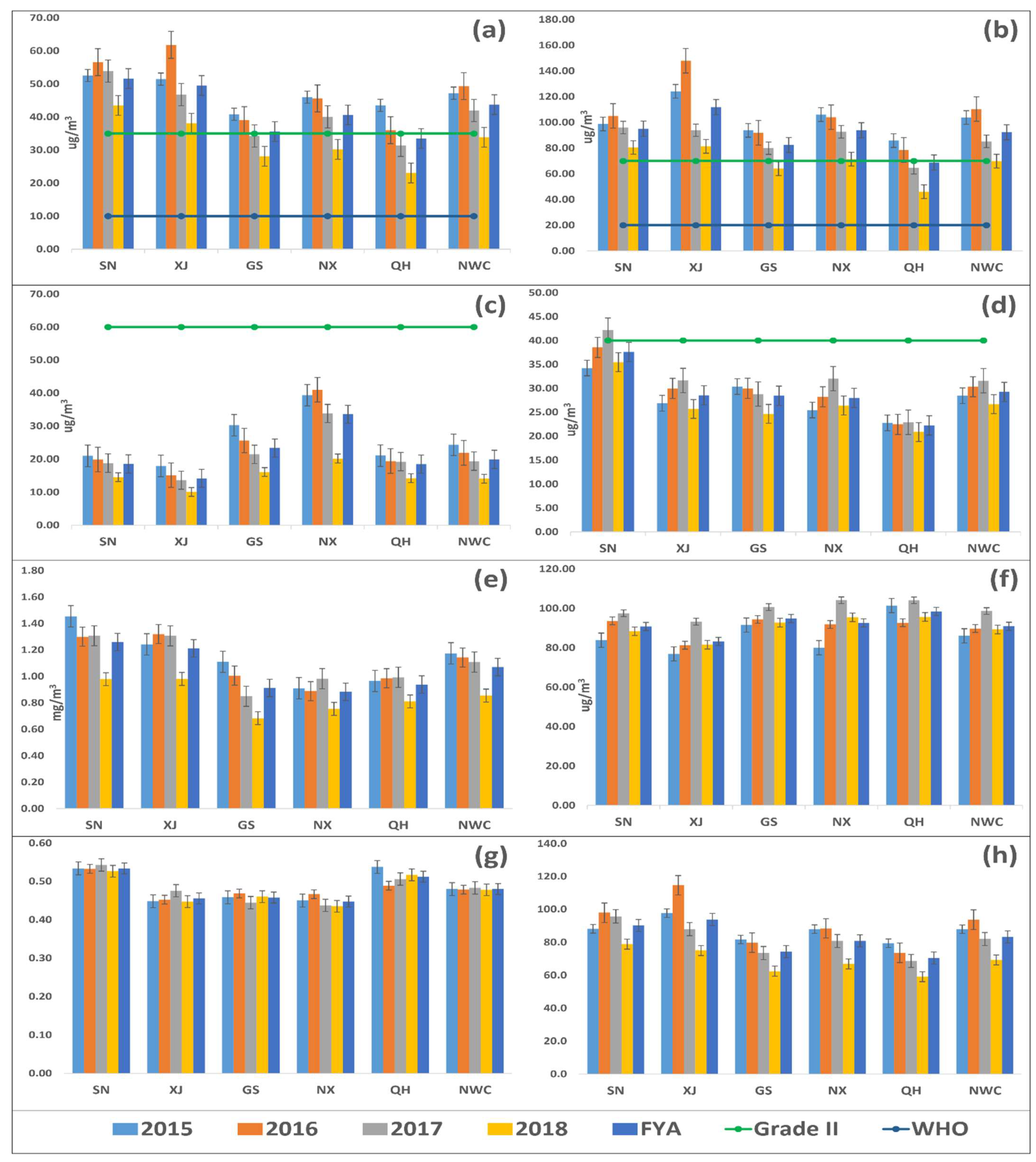
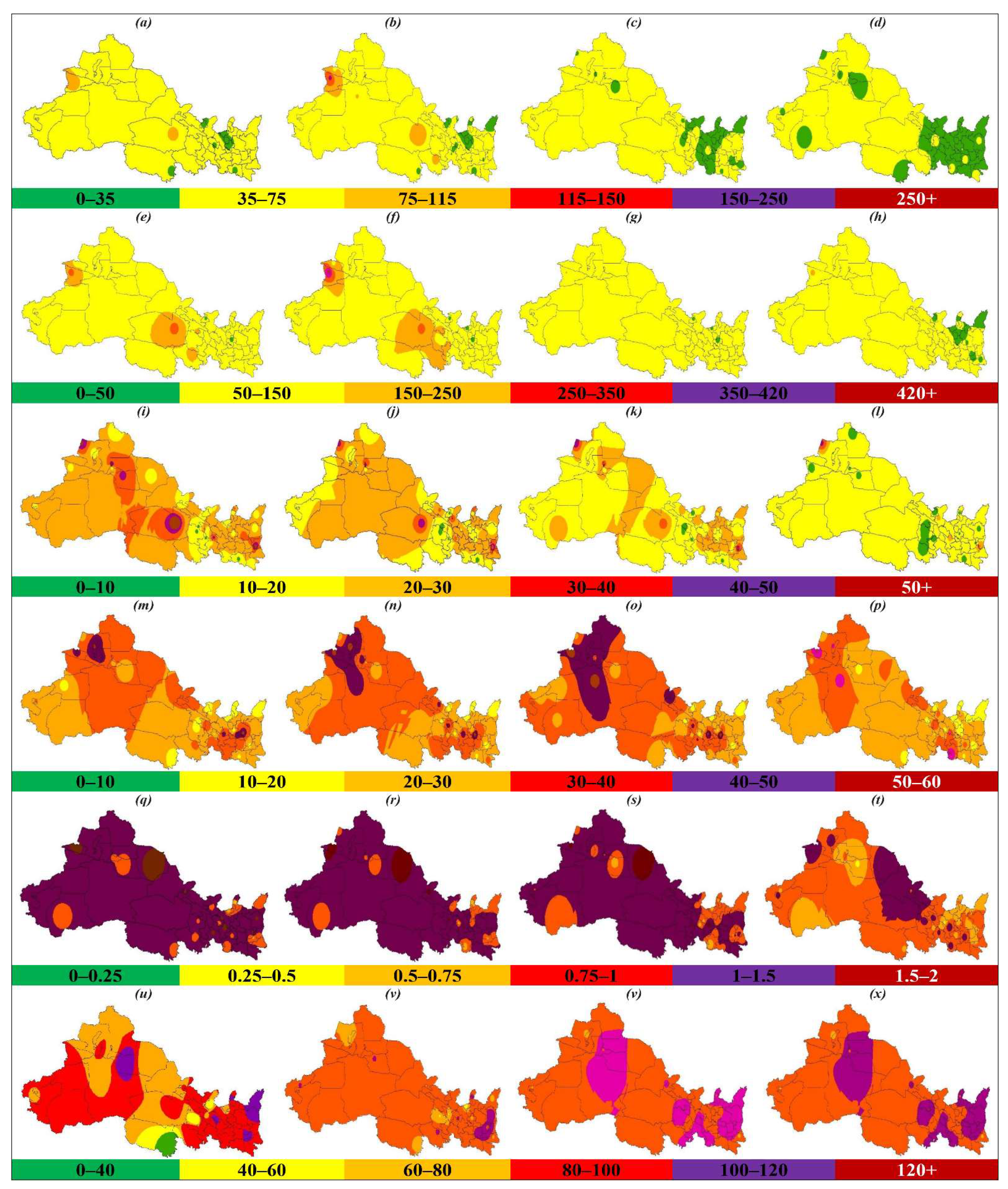
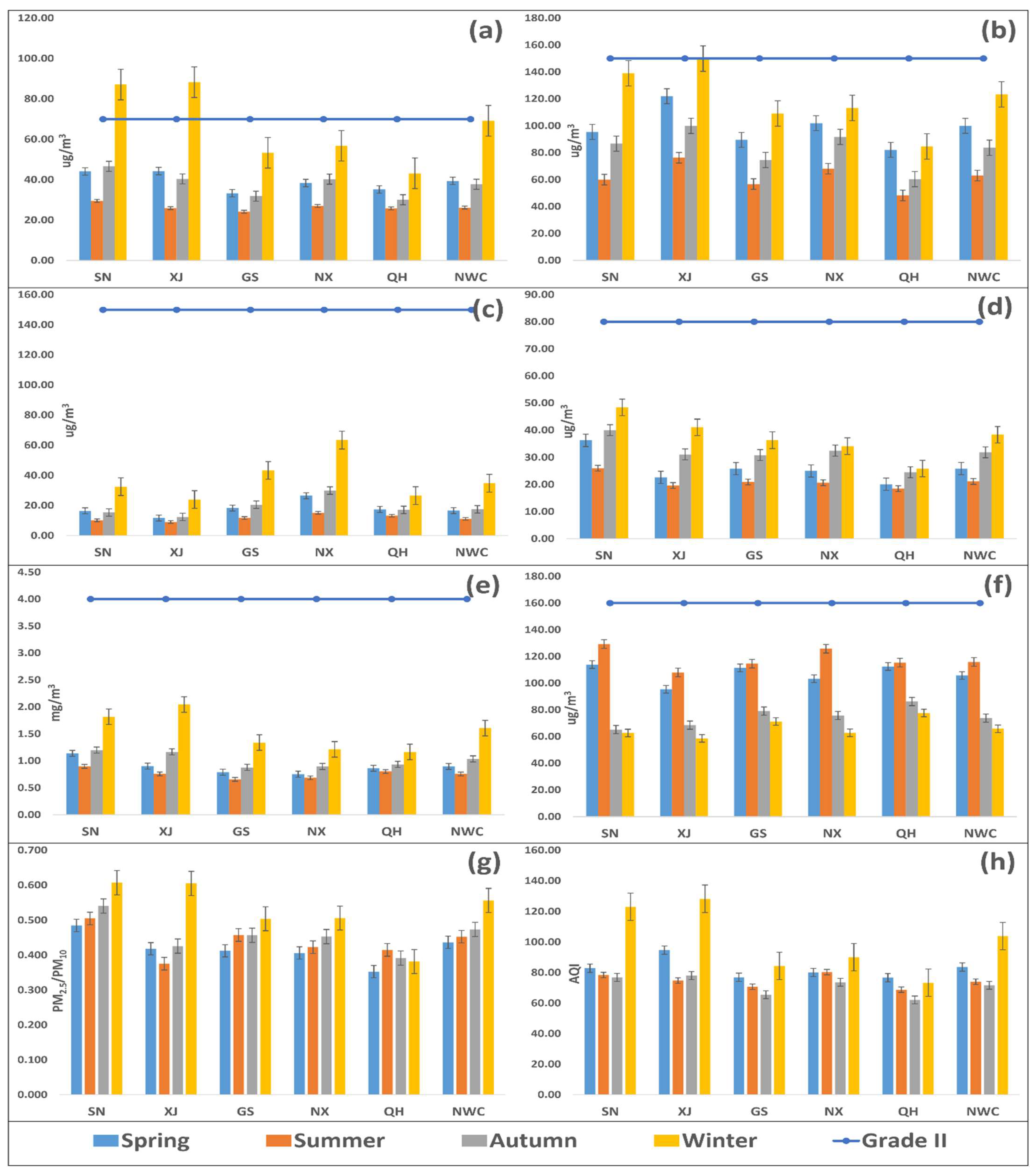
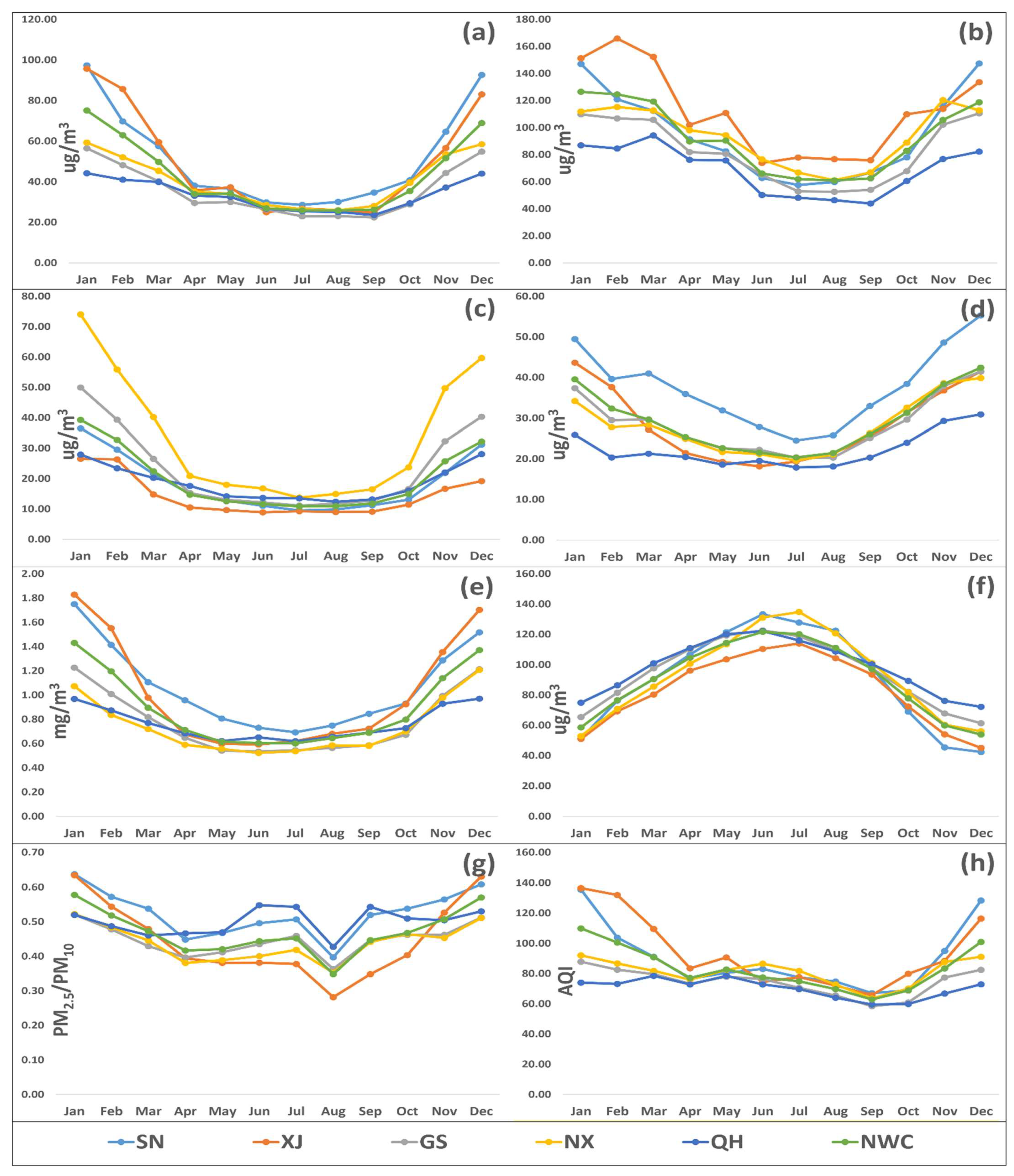
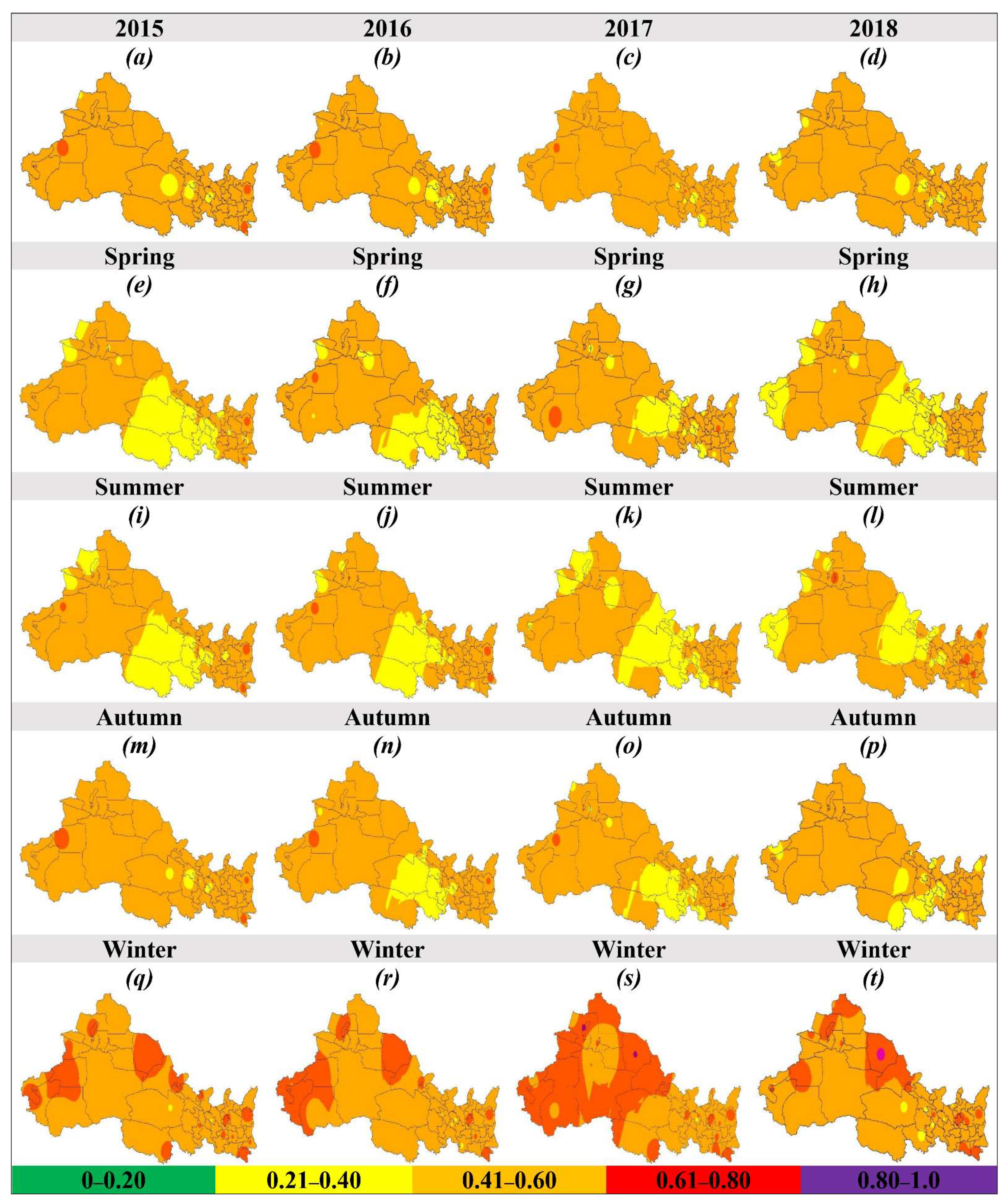
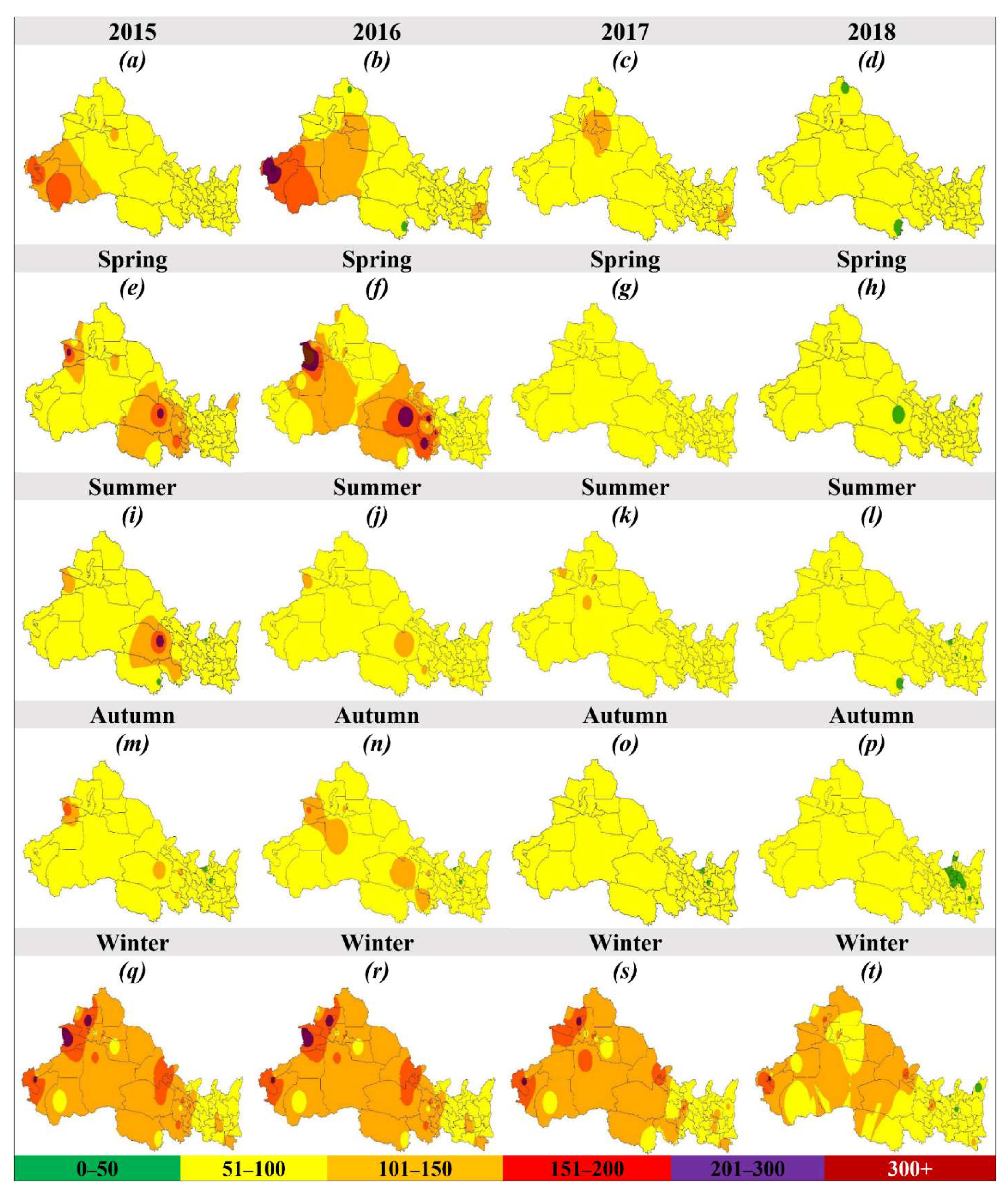
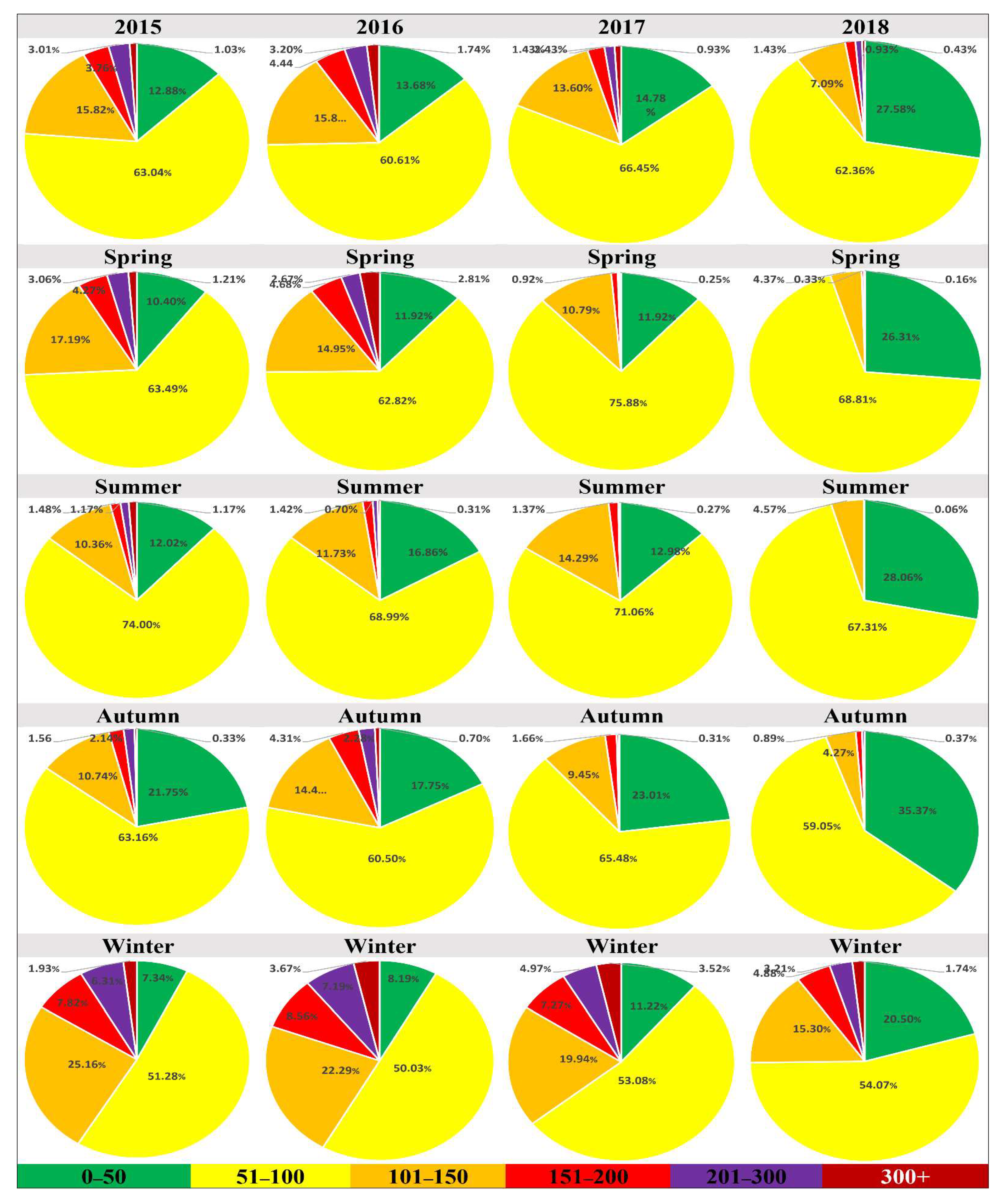
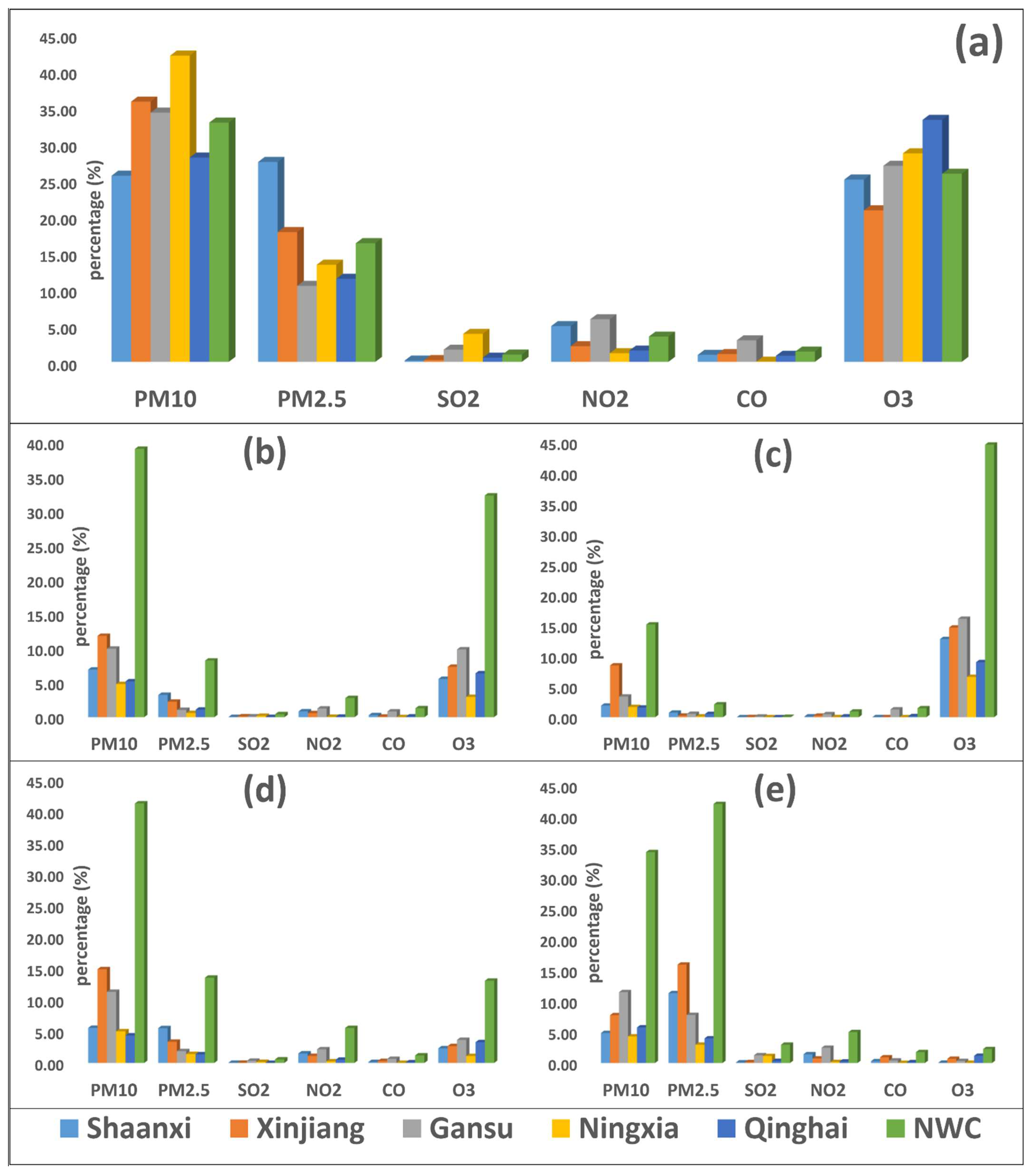
| Province | City | Population (million) | Area (km²) | Monitoring Stations | Attainment (%) | |||
|---|---|---|---|---|---|---|---|---|
| 2015 | 2016 | 2017 | 2018 | |||||
| Shaanxi (SX) | Ankang | 2.63 | 23,536 | 3 | 20.27 | 17.49 | 13.70 | 8.49 |
| Baoji | 3.717 | 18,712 | 8 | 23.56 | 36.61 | 33.42 | 21.64 | |
| Hanzhong | 3.84 | 27,246 | 4 | 20.82 | 25.68 | 27.12 | 14.25 | |
| Shanglou | 2.34 | 19,587 | 2 | 15.34 | 15.85 | 7.67 | 3.29 | |
| Tongchuan | 0.83 | 3882 | 4 | 24.93 | 44.54 | 31.51 | 21.37 | |
| Weinan | 5.52 | 13,134 | 4 | 27.40 | 54.10 | 54.52 | 33.42 | |
| Xian | 12 | 10,097 | 13 | 30.14 | 47.54 | 50.14 | 36.16 | |
| Xianyang | 5.096 | 10,213 | 4 | 27.12 | 53.55 | 55.89 | 24.93 | |
| Yannan | 2.198 | 37,000 | 4 | 22.47 | 21.04 | 13.97 | 3.29 | |
| Yulin | 3.38 | 43,578 | 4 | 19.73 | 19.67 | 22.74 | 9.32 | |
| Xinjiang (XJ) | Aksu | 2.37 | 127,144.91 | 2 | 52.60 | 72.68 | 23.56 | 18.63 |
| Altay | 0.526 | 117,699.01 | 2 | 0.27 | 0.00 | 0.00 | 0.00 | |
| Bortala | 0.443 | 24,934.33 | 2 | 9.32 | 9.56 | 10.68 | 6.30 | |
| Crete | 0.525 | 72,468.08 | 1 | 49.32 | 50.27 | 21.64 | 16.99 | |
| Changji | 1.428 | 73,139.75 | 3 | 18.63 | 26.78 | 29.32 | 24.66 | |
| Hami | 0.572 | 142,094.88 | 2 | 16.99 | 12.57 | 5.48 | 1.37 | |
| Hotan | 2.014 | 249,146.59 | 2 | 75.07 | 73.77 | 19.18 | 12.05 | |
| Ili | 2.482 | 56,381.53 | 3 | 14.79 | 16.94 | 23.56 | 20.55 | |
| Karamy | 0.39 | 8654.08 | 5 | 8.49 | 9.02 | 11.78 | 8.22 | |
| Korla | 1.278 | 470,954.25 | 3 | 31.51 | 44.26 | 34.79 | 8.77 | |
| Kashgar | 3.979 | 137,578.51 | 3 | 71.51 | 77.32 | 40.82 | 30.96 | |
| Shihezi | 0.635 | 456.84 | 2 | 21.92 | 25.41 | 37.53 | 25.75 | |
| Tacheng | 1.219 | 94,698.18 | 1 | 0.00 | 0.27 | 0.27 | 0.27 | |
| Turpan | 0.622 | 67,562.91 | 2 | 36.16 | 55.19 | 32.33 | 21.64 | |
| Urumqi | 3.11 | 13,787.90 | 7 | 33.97 | 31.69 | 33.15 | 23.56 | |
| Wujiaqu | 0.09 | 742 | 1 | 23.84 | 33.33 | 32.60 | 25.75 | |
| Gansu (GS) | Dingxi | 3.031 | 19,609 | 2 | 16.71 | 12.84 | 8.22 | 3.29 |
| Gannan | 0.689 | 40,898 | 1 | 18.36 | 15.03 | 8.77 | 2.74 | |
| Jiayuguan | 0.231 | 2935 | 2 | 18.08 | 17.76 | 4.38 | 1.92 | |
| Jinchang | 0.228 | 8896 | 3 | 20.55 | 20.77 | 7.67 | 2.74 | |
| Jiuquan | 1.096 | 191,342 | 2 | 26.58 | 35.52 | 31.78 | 21.10 | |
| Lanzhou | 3.61 | 13,300 | 5 | 21.64 | 15.30 | 15.89 | 4.66 | |
| Linxia | 0.25 | 88.6 | 2 | 7.12 | 7.10 | 6.03 | 2.47 | |
| Longnan | 2.567 | 27,000 | 2 | 18.08 | 10.66 | 3.56 | 0.27 | |
| Pinglian | 2.068 | 11,196 | 2 | 21.64 | 14.75 | 6.03 | 2.74 | |
| Qingyang | 2.21 | 27,119 | 3 | 15.07 | 12.30 | 7.95 | 1.92 | |
| Silver City | 1.708 | 21,200 | 2 | 24.38 | 17.49 | 7.95 | 3.29 | |
| Tianshui | 3.262 | 14,300 | 3 | 15.34 | 16.12 | 7.40 | 6.03 | |
| Wuwei | 1.815 | 33,000 | 2 | 17.53 | 15.85 | 6.85 | 1.92 | |
| Zhangye | 1.2 | 42,000 | 2 | 23.29 | 14.48 | 5.48 | 0.27 | |
| Ningxia (NX) | Guyuan | 1.45 | 14,413 | 3 | 12.88 | 13.11 | 4.38 | 1.10 |
| Shizuishan | 0.73 | 5208.13 | 4 | 38.08 | 33.33 | 24.38 | 9.86 | |
| Yinchuan | 2.293 | 8874.61 | 3 | 25.75 | 23.50 | 13.70 | 4.93 | |
| Wuzhong | 1.3 | 16,758 | 6 | 26.03 | 29.23 | 30.68 | 9.59 | |
| Zhongwei | 1.041 | 16,986 | 3 | 24.66 | 21.04 | 16.16 | 2.74 | |
| Qinghai (QH) | Guoluo/Golog | 0.181 | 76,312 | 1 | 8.22 | 4.10 | 5.48 | 1.92 |
| Haibei | 0.273 | 39,354 | 1 | 19.73 | 15.57 | 2.47 | 0.82 | |
| Haidong | 1.396 | 12,810 | 1 | 27.67 | 21.86 | 12.60 | 7.40 | |
| Hainan | 0.441 | 45,895 | 1 | 16.99 | 9.29 | 4.11 | 1.37 | |
| Haixi | 0.515 | 325,785 | 1 | 14.79 | 6.83 | 2.19 | 0.00 | |
| Huanggnan | 0.256 | 17,921 | 1 | 33.97 | 30.33 | 27.40 | 21.64 | |
| Xinning | 2.208 | 7372 | 4 | 18.90 | 25.68 | 13.15 | 4.66 | |
| Yushu/Gyegu | 0.12 | 13,462 | 1 | 5.48 | 1.91 | 1.10 | 0.27 | |
Publisher’s Note: MDPI stays neutral with regard to jurisdictional claims in published maps and institutional affiliations. |
© 2022 by the authors. Licensee MDPI, Basel, Switzerland. This article is an open access article distributed under the terms and conditions of the Creative Commons Attribution (CC BY) license (https://creativecommons.org/licenses/by/4.0/).
Share and Cite
Zaib, S.; Lu, J.; Bilal, M. Spatio-Temporal Characteristics of Air Quality Index (AQI) over Northwest China. Atmosphere 2022, 13, 375. https://doi.org/10.3390/atmos13030375
Zaib S, Lu J, Bilal M. Spatio-Temporal Characteristics of Air Quality Index (AQI) over Northwest China. Atmosphere. 2022; 13(3):375. https://doi.org/10.3390/atmos13030375
Chicago/Turabian StyleZaib, Shah, Jianjiang Lu, and Muhammad Bilal. 2022. "Spatio-Temporal Characteristics of Air Quality Index (AQI) over Northwest China" Atmosphere 13, no. 3: 375. https://doi.org/10.3390/atmos13030375
APA StyleZaib, S., Lu, J., & Bilal, M. (2022). Spatio-Temporal Characteristics of Air Quality Index (AQI) over Northwest China. Atmosphere, 13(3), 375. https://doi.org/10.3390/atmos13030375







